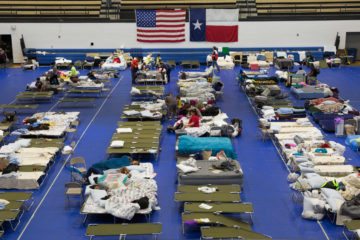“If you’ve lost your job, your house, that type of thing, you can apply for disaster SNAP,” said Rachel Cooper, a senior policy analyst at the Center for Public Policy Priorities. “It’s something the folks in these areas need really quickly.”
But Texans trying to rebuild their lives in the aftermath of Hurricane Harvey can’t avail themselves of D-SNAP benefits until USDA and the state of Texas agree on how the program will be administered. The state’s Health and Human Services Commission (HHSC) and USDA have begun negotiations on how to enact the program, but so far aid has not been approved. Cooper says the longer the talks go on without a deal, the more people will go hungry.
“It could be tens of thousands or hundreds of thousands of people [who qualify for the program],” she said. “We’ve got damage from Corpus to Beaumont and people who are simply out of work.”
It’s unknown why Texas hasn’t launched the emergency program yet. In a news release, HHSC said the the state is “continuing discussions with the federal government about the possibility of a Disaster-SNAP waiver.” USDA Secretary Sonny Perdue wrote in a statement that “President Trump made it clear to his cabinet that helping people is the first priority, and that process and paperwork can wait until later.” But Perdue also offered this caveat: D-SNAP could be activated only “after commercial channels of food distribution have been restored and families are able to prepare food at home.”
D-SNAP approval has happened relatively quickly in the past. Ten days after eastern Louisiana was ravaged by prolonged flooding in 2016, state and federal authorities brokered a deal to activate the program, doling out $48.9 million in food assistance to 122,000 households. Authorities later agreed to extend the program, giving an additional $40 million in benefits. But sometimes the approval process lags, such as when New Jersey launched D-SNAP almost three weeks after Superstorm Sandy laid waste to the state in 2012.
Renee Treviño, an attorney at Texas RioGrande Legal Aid, said political ideology may be hindering negotiations to secure D-SNAP after Harvey. In his proposed budget for fiscal year 2018, Trump cuts more than $190 billion in federal spending from SNAP over 10 years. The budget also proposes levying a fee on retailers who accept food stamps, a move that drew concern from the grocery store industry and some members of Congress.
“It’s a matter of the willingness of Texas and the federal government to take action on a program where it’s their intention to cut, not augment,” Treviño said. “In general, we’re in a period of time where those in control would rather cut assistance to low-income people than provide basic food, nutrition and medical care.”
Last week, Texas and the feds announced an agreement to waive some SNAP rules, such as one prohibiting enrollees from using food stamps to buy prepared foods and another to expedite the transfer of benefits to enrollees’ SNAP debit cards. Still, the government’s food aid response won’t be comprehensive until D-SNAP is approved.
“The longer this is delayed, the longer the people with the most need are affected,” Treviño said.


